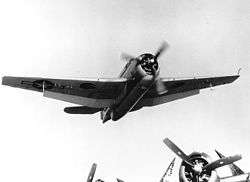VA-95 (U.S. Navy)

TBM-1 Avenger torpedo bomber flies low over the flight deck of an escort carrier after a wave off. VA-95 flew similar aircraft.
VA-95 was an Attack Squadron of the U.S. Navy. It was established as Torpedo Squadron VT-20 on 15 October 1943, and as VA-10A on 15 November 1946. It was finally redesignated as VA-95 on 12 August 1948. The squadron was disestablished on 30 November 1949. Its nickname is unknown.[1]
Two other squadrons, unrelated to this one, subsequently bore the VA-95 designation.[1]
Significant events
- 1 Sep 1944: The squadron’s first combat action involved strikes against shore installations on Chichi Jima in the Bonin Islands.
- Sep 1944: Squadron aircraft participated in strikes against Palau Islands in preparation for and support of the landings on Peleliu Island.
- Oct 1944: The squadron participated in strikes against Okinawa, Formosa and Luzon in preparation for and support of the landings on Leyte.
- 15 Oct 1944: Lieutenant Edward B. Holley, flying a squadron TBM, shot down a Zero, Mitsubishi A6M fighter, over Luzon.
- 24 Oct 1944: The squadron participated in the Battle for Leyte Gulf. VT-20’s TBM-1Cs flew sorties against a powerful Japanese surface force in the Sibuyan Sea. These attacks contrtibuted to the sinking of the mighty Musashi, one of the two largest battleships in the world. The following squadron personnel were awarded the Navy Cross for their action against the Japanese task force: Ensigns W. T. Ross, W. J. Schaller, and G. Swint III; Lieutenant (jg) M. Throwbridge; Lieutenants C. H. H. Dickey, E. B. Holley, and R. E. McHenry, and Lieutenant Commander S. L. Prickett.
- 25 Oct 1944: Squadron aircraft were part of the Fast Carrier Task Force that attacked the Japanese carrier force in the Battle of Cape Engano. Four Japanese carriers were sunk during this engagement. The following squadron personnel were awarded the Navy Cross for their action during the Battle of Cape Engano: Ensigns T. E. Armour, J. L. Baxter, M. H. Krouse, and C. D. Leeper; Lieutenant (jg)s P. H. Bradley and C. F. Schlegel; and Lieutenants J. H. Howell, Jr., M. L. Leedom, E. E. Rodenburg, and R. J. Savage.
- Nov 1944: The squadron participated in strikes against a Japanese troop convoy in Ormoc Bay, Leyte and enemy positions on Luzon.
- Dec 1944: Strikes were flown against Luzon in preparation for the landings at Lingayan Gulf, Luzon.
- Jan 1945: Squadron aircraft flew strikes against Luzon, Formosa, Hong Kong, Japanese convoys in South China Sea and along coast of French Indochina, and Okinawa.
- 12 Jan 1945: Lieutenant J. N. Howell, Jr and Lieutenant (jg) M. Throwbridge were awarded the Silver Star Medal for their action against a Japanese cruiser that was protecting a convoy off the coast of French Indochina. Their attacks contributed to the sinking of the cruiser.[1]
Home port assignments
The squadron was assigned to these home ports, effective on the dates shown:[1]
- NAS San Diego – 15 Oct 1943
- NAS Barbers Point – 21 Apr 1944*
- NAS Puunene – 17 Jun 1944*
- NAS San Diego – 23 Feb 1945
- NAAF Lewiston – 16 Apr 1945
- NAAS Edenton – Jun 1945
- NAAS Elizabeth City – 02 Nov 1945
- NAAS Charlestown – 21 Mar 1946
* Temporary shore assignment while the squadron conducted training in preparation for combat deployment.
Aircraft Assignment
The squadron first received the following aircraft on the dates shown:[1]
- TBF-1/TBM-1 Avenger – Nov 1943
- TBM-1C Avenger – Feb 1944
- TBM-3E Avenger – Jul 1945
- AD-1 Skyraider – 01 Aug 1949
See also
- Second VA-95 (U.S. Navy)
- Third VA-95 (U.S. Navy)
- Attack aircraft
- List of inactive United States Navy aircraft squadrons
- History of the United States Navy
References
This article incorporates text from the public domain Dictionary of American Naval Aviation Squadrons.
| ||||||||||||||||||||||||||||||||||||||||||||||||||||||||||||||||||||||||||||||
This article is issued from Wikipedia - version of the Monday, April 27, 2015. The text is available under the Creative Commons Attribution/Share Alike but additional terms may apply for the media files.
